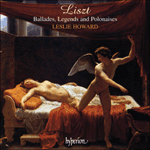Composed between 1845 and 1848 (i.e., before Chopin’s death), the Ballade No 1 is a sadly underrated work. The subtitle ‘Le chant du croisé’ (‘croisé’ means ‘crusader’ rather than ‘cross’) suggests an underlying narrative that Liszt declined to elaborate further, but the work is an evocation of the period of the Crusades (which given Liszt’s Catholicism is an apt subject). The initial rising motif alludes strongly to the opening of Chopin’s First Ballade, a debt that must have been conscious on Liszt’s part, while the answering idea is a scherzo-like gesture that seems to confirm the key of D major. The main body of the work, however, is cast as a set of character variations on the crusader’s ‘song’ in D flat major, with a joyfully heroic march as a middle section, replete with ‘rapido con bravura’ scales and other virtuoso intricacies.
from notes by Tim Parry © 2000
Composée entre 1845 et 1848, la Première Ballade est une œuvre encore malheureusement trop souvent sous-estimée. Le sous-titre «Chant du croisé» suggère une trame narrative que Liszt ne précisa point. Cette partition évoque certainement la période des Croisades (un sujet approprié considéré la force des sentiments catholiques de Liszt). Le motif ascendant initial fait indubitablement penser à la Première Ballade de Chopin, une dette certainement consciente de la part de Liszt. Quant à la réponse, il s’agit d’une tournure à la manière d’un scherzo confirmant la tonalité de ré majeur. Le corps même de l’œuvre s’articule autour de variations sur le «Chant du croisé» en ré bémol majeur, avec pour section centrale une marche héroïque pleine d’allégresse, riche en gammes «rapido con bravura» et autres délices virtuoses.
extrait des notes rédigées par Tim Parry © 2000
Français: Isabelle Battioni
Zwischen 1845 und 1848 (d.h. vor Chopins Tod) komponiert, ist die Erste Ballade ein allzu oft unterschätztes Werk. Der Untertitel „Le chant du croisé“ (wobei hier „croisè“ eher Kreuzritter als Kreuz meint) läßt auf eine zugrundeliegende Fabel schließen, zu der sich Liszt nicht weiter geäußert hat, aber jedenfalls beschwört das Stück die Zeit der Kreuzzüge herauf (was als Thema zu Liszts Katholizismus paßt). Das anfängliche ansteigende Motiv bezieht sich stark auf die Eröffnung von Chopins Erster Ballade, eine Schuld, deren sich Liszt bewußt gewesen sein muß, denn der antwortende Gedanke ist eine scherzoähnliche Geste, die die Tonart D-Dur zu bekräftigen scheint. Der Hauptteil des Werkes ist jedoch als eine Reihe von Charaktervariatonen über das „Kreuzritterlied“ in des-Moll gestaltet, mit einem frohgestimmt heroischen Marsch im Mittelteil, reich an „rapido con bravura“ gespielten Tonleitern und anderen virtuosen Feinheiten.
aus dem Begleittext von Tim Parry © 2000
Deutsch: Anne Steeb/Bernd Müller


 Liszt: Complete Piano Music
Liszt: Complete Piano Music Liszt: The complete music for solo piano, Vol. 2 - Ballades, Legends & Polonaises
Liszt: The complete music for solo piano, Vol. 2 - Ballades, Legends & Polonaises
